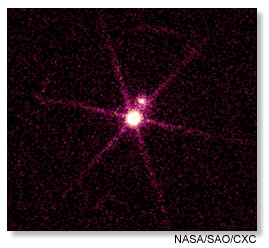
October 9, 2000 Cambridge, Massachusetts - The Chandra X-ray Observatory has been revealing layers of the cosmos around us with beautiful clarity. One of its x-ray images from October 1999 shows the Sirius A and B star system located 8.6 light years from Earth. The large central light is Sirius A, the brightest star in the northern sky in optical light. Sirius B is a white dwarf that is ten thousand times dimmer, but clearly shows up in x-rays. Because the two stars are so close together, Sirius B was not discovered until 1862 by Alvan Clark using the best optical telescope in the world at the time. The pink sapphire pattern is produced by the satellite's transmission grating. For comparison, below is an optical image by Arizona's McDonald Observatory.
Click here to subscribe and get instant access to read this report.
Click here to check your existing subscription status.
Existing members, login below:
© 1998 - 2024 by Linda Moulton Howe.
All Rights Reserved.

